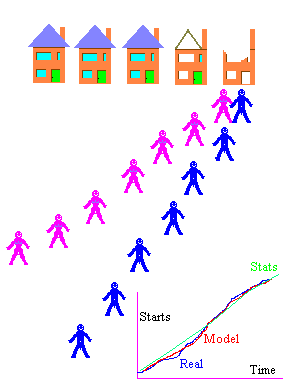Dynamic simulation model of micro-economic and market sectors.
MJMcCann Consulting

Housing Market Dynamics.
The usual statistical approach.
The government statistical view was based on tracking house building and making projections based on the trend analysis. Over a period of time when there was great activity in the market (post war UK: 1945-1970) the trend had been upwards and activity was reasonably well projected by a gently changing, increasing level of activity. At the same time, correlations were made with mortgage interest rates and disposable income etc.
 Not the usual Statistical Approach.
Not the usual Statistical Approach.
We took a different approach. We wanted to know what really were the underlying drivers for the construction industry because our client had a lot of customers there and big development costs being dedicated to it. We recognised that for the next two decades, all the people who would be buying houses had already been born. We took account of the age specific activity rates, such as ages of marriage, rate of births per family, number of divorces and ages of divorcees and so on.
It turns out that many of these parameters change very slowly, society develops its norms of behaviour much more slowly than governments can change the rules. We created a model of the housing stock and the demographic distributions in the population and looked at how the resulting rate of household formation, which includes all the new singles as well as nuclear families, would create a demand for places to live. (dwellings including apartments (flats) as well as single family homes).
Good match to reality
From 1945 on to about 1970, our intrinsic demand model tracked the observed rate of creation of dwellings quite well. There was a glitch period, with far fewer houses built than our model predicted, but then we discovered that it had been a period of government imposed building restrictions (for material shortages). After the glitch, the real world caught up with our model again.
Projections into the Future
The next question was "what of the future?" The government sponsored statistical model said more of the same. When the house building market turned down one year, the trend line automatically adapted to droop a bit. Our model gave a different view; it said the bottom would drop out of the house building market over the next three years or so because the demographic drivers had gone. Indeed they had. In the next two years, just as we predicted, the market collapsed. The statistical projection was no help.
Other Experience
My experience with problems over these time scales is that people rarely expand their time horizons far enough to see the whole picture. Even if they try, they tend to miss interaction effects and think more in terms of extrapolating, sometimes with statistical models, from the recent past. My (MJMcC) observation is that the demographics and the compelling force of reality can be quantified to make a big improvement in perception. You only have to contact me to get help!
Home/Index Page
About Dr McCann
Summary
Dr M.J.McCann
Training Courses
Bristol University
Contacting me
Contact in UK
Location USA
Philosophy
Software Tools
Fees
Confidentiality
Business & Commerce
TV Advertising
Drugs Competition
Housing Demand
Automobiles Demand
Wallcoverings Battle
Cash Flow
Human Resources
Project Management
Patent Analysis
Chemical Industry
Cooling Tower
Fermentation
Polymer Process
Heat exchange
Supercritical Fluid
Distributed parameter
Toxic gas allocation
Electrical
Control systems
Initiation systems
Ferrite Filters
Microstrip Antennas
Lightning
Production & Process
Automated manufacture
Crimp and Press
Glass making
Glass molding
Glass to metal seals
Heat exchanger
Helium Leak Testing
RF Soldering
Vacuum web coating
If you have a problem with the behaviour of a market sector, plant, process or item of equipment and would like to get a quantitative handle on it to improve yield or optimise performance, then contact me. I'm always ready to give a little time to discuss a new puzzle, in confidence, of course. We'll only worry about fees when there is some defined work. I can be flexible about how I work with you.
Top
POB 902,
Chadds Ford PA
19317 USA.
T: 1 302 654-2953
M: 1 302 377-1508 (Cell)
E: mjmccann@ieee.org
File: housing.htm
 Applications
Applications